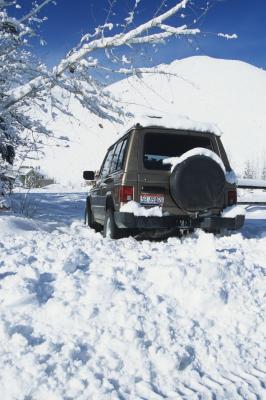
Driving in the snow can be especially challenging and hazardous. Slippery conditions lead to a loss of traction and make it difficult for drivers to maintain control of their vehicles. Drivers who live in areas with severe winters and hills should be especially cautious driving in snowy weather. Four-wheel-drive and all-wheel-drive vehicles offer several advantages for handling extreme winter conditions.
There are two basic types of 4WD systems, part-time and full-time or permanent. Part-time 4WD is the more common of the two. The driver chooses whether to operate the vehicle in two-wheel drive 2WD or 4WD depending on road conditions. In most part-time 4WD vehicles the driver shifts the vehicle into 4WD or 4WD Low by manipulating a shift lever. Most vehicles with part-time 4WD must be at a complete stop to shift into 4WD, though some newer models offer "shift on the fly" capability, enabling the driver to shift from 2WD to 4WD and back while the car is in motion. Older vehicles (and some modern heavy-duty vehicles) with part-time 4WD require the driver to get out of the vehicle and manually lock the hubs on the front wheels to engage 4WD. In both types of 4WD power is equally distributed between both axles by gears.
In vehicles equipped with AWD the system is always on, there is no shifting between 2WD and 4WD. Like 4WD vehicles, power is sent to both axles, but AWD systems use a torque converter (viscous coupling) to divide the power between the axles.
Vehicles with 4WD are especially effective in dealing with heavy snow, unplowed roads, off-road driving and maintaining traction on hills. When in the 4WD low range, these vehicles can get up even steep snow-covered hills.
Most 4WD vehicles operate in rear-wheel 2WD most of the time. Most rear-wheel 2WD vehicles have less traction than front-wheel drive vehicles, so unless the vehicle is in 4WD mode it actually has inferior gripping ability. Part-time 4WD vehicles can not be operated on dry pavement without danger of damaging the components. The addition of either system adds weight and cost to the vehicle, both in the upfront purchase price and in the ongoing operational costs due to lower gas mileage than a comparable model without 4WD or AWD.
One of the main advantages of AWD is that it transfers power to the axles with the most traction without requiring any input from the driver. Some systems can even direct power to individual wheels. Unlike 4WD vehicles which evenly distribute power between both axles, AWD systems can shift as much as 90 percent of the engine's power to the front or rear axle as the situation warrants.
Vehicles with AWD are not meant for off-road use and do not have a low gear range, as do 4WD vehicles.